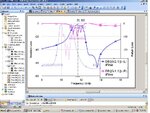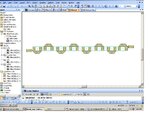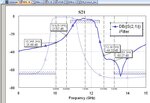shyamss
Newbie level 3
i'm designing a Microstrip narrowband BPF at center frequency 11.65GHz on substrate RT Duroid-6010LM having εr=10.2 using AWR Microwave office.. i've selected the Hairpin design methodology for my design. and i found my order of the filter as 7th order. i want rejection of 65dB at 10.05GHz and 13.25GHz, this was achieved in the schematic design in the tool. for any higher frequency design we've to go for the EM simulation, so i did the EM simulation using AXIEM simulator. But where i'm losing the Rejection at the given band to the half (ie., 30db or so) at both side of the skirt. So i've increased the order to 8 even though i've increased the Rejection to 40dB not more than that. and even i've given with the Constrains of length×width×height so if i further increase my order to achieve Rejection i'll be violating the constrains. So what do i want to do to increase the rejection at the skirts with the 7th or the 8th order.. Someone plz help with this regard.


